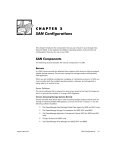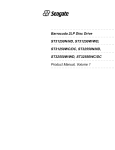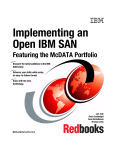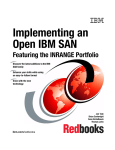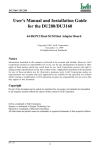Download Qlogic QLA2000F Installation guide
Transcript
™ Corp. Hardware Installation Guide for the QLA2000/2000F/2100/2100F/2102F Fibre Channel Host Adapter Boards for the PCI Bus FC0151102-00 D April 16, 1999 QLogic Corporation Information furnished in this manual is believed to be accurate and reliable. However, QLogic Corporation assumes no responsibility for its use, nor for any infringements of patents or other rights of third parties which may result from its use. QLogic Corporation reserves the right to change product specifications at any time without notice. Applications described in this document for any of these products are for illustrative purposes only. QLogic Corporation makes no representation nor warranty that such applications are suitable for the specified use without further testing or modification. QLogic Corporation assumes no responsibility for any errors that may appear in this document. No part of this document may be copied nor reproduced by any means, nor translated nor transmitted to any magnetic medium without the express written consent of QLogic Corporation. QLogic is a trademark of QLogic Corporation. Seagate is a trademark of Seagate Technology, Inc. Microsoft is a trademark of Microsoft Corporation. All other brand and product names are trademarks or registered trademarks of their respective holders. Document Revision History Rev. A initial release, 1/28/98 Rev. B update, 4/17/98 (QLA2000/2000F boards added) Rev. C update, 11/10/98 (QLA2200/2200F boards added) Rev. D update, 4/16/99 (QLA2102F board added, QLA2200/2200F boards removed) Boards Affected QLA2000 QLA2000F QLA2100 QLA2100F QLA2102F Copyright 1999 QLogic Corporation First Printed: January 1998 All Rights Reserved Worldwide Printed in U.S.A Page ii FC0151102-00 D Table of Contents Quick Installation Instructions Section 1 1.1 1.2 1.3 1.3.1 2.1 2.2 2.3 2.4 A.1 A.2 A.2.1 A.2.2 A.2.3 A.2.4 A.2.5 A.3 3-1 3-1 3-2 3-2 Fast!UTIL Introduction . . . . . . . . . . . . . . . . . . . . . . . . . . . . . . . . . . . . . Configuration Settings . . . . . . . . . . . . . . . . . . . . . . . . . . . . . Host Adapter Settings . . . . . . . . . . . . . . . . . . . . . . . . . . . Selectable Boot Settings . . . . . . . . . . . . . . . . . . . . . . . . . Restore Default Settings . . . . . . . . . . . . . . . . . . . . . . . . . Raw NVRAM Data . . . . . . . . . . . . . . . . . . . . . . . . . . . . . Advanced Adapter Settings . . . . . . . . . . . . . . . . . . . . . . . Scan Fibre Channel Devices . . . . . . . . . . . . . . . . . . . . . . . . FC0151102-00 D 2-1 2-1 2-4 2-4 Troubleshooting Problems After Installation . . . . . . . . . . . . . . . . . . . . . . . . . . Hardware Problem Checklist . . . . . . . . . . . . . . . . . . . . . . . . System Configuration Problem Checklist. . . . . . . . . . . . . . . Fibre Channel Problem Checklist . . . . . . . . . . . . . . . . . . . . . Appendix A 1-1 1-1 1-2 1-2 Hardware Installation Preinstallation Procedures. . . . . . . . . . . . . . . . . . . . . . . . . . . What You Need for Installation . . . . . . . . . . . . . . . . . . . . . . Power Supply . . . . . . . . . . . . . . . . . . . . . . . . . . . . . . . . . . . . Installation in the Computer . . . . . . . . . . . . . . . . . . . . . . . . . jSection 3 3.1 3.2 3.3 3.4 Introduction General Description . . . . . . . . . . . . . . . . . . . . . . . . . . . . . . . What is Fibre Channel?. . . . . . . . . . . . . . . . . . . . . . . . . . . . . Features . . . . . . . . . . . . . . . . . . . . . . . . . . . . . . . . . . . . . . . . . Mixed Peripheral Support . . . . . . . . . . . . . . . . . . . . . . . . Section 2 v A-1 A-1 A-1 A-2 A-2 A-3 A-3 A-5 Page iii Table of Contents A.4 A.5 QLA2000/2000F/2100/2100F/2102F Hardware Installation Guide Fibre Disk Utility . . . . . . . . . . . . . . . . . . . . . . . . . . . . . . . . Select Host Adapter . . . . . . . . . . . . . . . . . . . . . . . . . . . . . . Appendix B A-5 A-5 Specifications FIGURES Figure 2-1 2-2 2-3 2-4 2-5 Page QLA2000 Board Layout. . . . . . . . . . . . . . . . . . . . . . . . . . . . . . . QLA2000F Board Layout. . . . . . . . . . . . . . . . . . . . . . . . . . . . . . QLA2100 Board Layout. . . . . . . . . . . . . . . . . . . . . . . . . . . . . . . QLA2100F Board Layout. . . . . . . . . . . . . . . . . . . . . . . . . . . . . . QLA2102F Board Layout. . . . . . . . . . . . . . . . . . . . . . . . . . . . . . 2-2 2-2 2-3 2-3 2-4 TABLES Table A-1 A-2 B-1 B-2 Page iv Page Host Adapter Settings. . . . . . . . . . . . . . . . . . . . . . . . . . . . . . . . . Advanced Adapter Settings . . . . . . . . . . . . . . . . . . . . . . . . . . . . QLA2xxx Board Operating Environment . . . . . . . . . . . . . . . . . QLA2xxx Board Specifications . . . . . . . . . . . . . . . . . . . . . . . . . A-1 A-3 B-1 B-1 FC0151102-00 D Quick Installation Instructions NOTE: The following QLogic host adapter boards are collectively referred to as the QLA2xxx board unless otherwise noted: QLA2000 (32-bit PCI to Fibre Channel copper media) QLA2000F (32-bit PCI to Fibre Channel optical media) QLA2100 (64-bit PCI to Fibre Channel copper media) QLA2100F (64-bit PCI to Fibre Channel optical media) QLA2102F (64-bit PCI to dual channel optical media) Using These Instructions Before installing your QLA2xxx board, take a moment to read this instruction guide. These instructions are a condensed version of the instructions in section 2. What You Need for Installation ❑ A screwdriver (usually a Phillips #1) ❑ A high-speed, serial data connector (HSSDC) cable for the QLA2000/2100 boards ❑ An optical, multimode cable with an SC-style duplex connector for the QLA2000F/2100F/2102F boards ❑ Two three-position point-to-point, internal fibre channel cables for the QLA2102F board Installing Your QLA2xxx Board CAUTION! The QLA2xxx board contains parts that can be damaged by electrostatic discharge (ESD). Before handling the QLA2xxx board, use standard methods to discharge static electricity. Keep the QLA2xxx board in the antistatic bag until you are ready to install it. Place the board on the bag when you examine or configure it. Retain the bag for future use. ❑ Check the motherboard and make any configuration changes necessary to accommodate the QLA2xxx board. ❑ Power down the peripheral devices, then the computer. ❑ Remove the computer cover. ❑ Install the QLA2xxx board in an appropriate slot. FC0151102-00 D Page v Quick Installation Instructions QLA2000/2000F/2100/2100F/2102F Installation Guide ❑ Connect the appropriate Fibre Channel peripheral cables. ❑ Replace the computer cover. ❑ Power up the peripherals, then the computer. Congratulations! You have successfully installed your new QLA2xxx board. See the appropriate QLogic software installation guide for information about the software drivers for the QLA2xxx board. Page vi FC0151102-00 D Section 1 Introduction NOTE: The following QLogic host adapter boards are collectively referred to as the QLA2xxx board unless otherwise noted: QLA2000 (32-bit PCI to Fibre Channel copper media) QLA2000F (32-bit PCI to Fibre Channel optical media) QLA2100 (64-bit PCI to Fibre Channel copper media) QLA2100F (64-bit PCI to Fibre Channel optical media) QLA2102F (64-bit PCI to dual channel optical media) 1.1 General Description Thank you for selecting the QLA2xxx Fibre Channel (FC) board. The QLA2xxx board is an intelligent, high-performance, DMA bus master host adapter designed for high-end systems. The intelligence and performance are derived from the ISP2xxx chips, making the QLA2xxx board a leading-edge host adapter. The ISP2xxx combines a powerful RISC processor, a fibre protocol module (FPM) with gigabit transceivers, and a peripheral component interconnect (PCI) local bus interface in a single-chip solution. The QLA2xxx board supports all FC peripherals that support private loop direct attach (PLDA) and fabric loop attach (FLA). Installation of the QLA2xxx board is quick and easy. 1.2 What is Fibre Channel? Fibre channel technology is outlined in the SCSI-3 Fibre Channel Protocol (SCSI-FCP) standard. Fibre Channel is a high-speed data transport technology used for mass storage and networking. It connects mainframes, super computers, workstations, storage devices, and servers. Using a Fibre Channel arbitrated loop (FC-AL), 126 devices can be supported, compared to 15 devices with Ultra SCSI. Fibre Channel supports data transfer rates of 100 Mbytes/sec on copper and optical interfaces, which is more than twice that of Ultra SCSI (40 Mbytes/sec). A copper interface is used for short connections (less than 30 meters); a multimode optical interface is used for intermediate distances (less than 500 meters). With increased connectivity and performance, Fibre Channel is the technology preferred and used by system designers. FC0151102-00 D 1-1 Features 1 – Introduction 1.3 Features ❑ Compliance with Intel PCI version 2.1 specification ❑ Compliance with Third Generation Fibre Channel Physical and Signaling Interface (FC-PH-3) standard ❑ Compliance with Fibre Channel-Arbitrated Loop (FC-AL) standard ❑ Compliance with U.S. and international safety and emissions standards ❑ Support for bus master DMA ❑ Fast!UTIL BIOS utility to customize the configuration parameters on the QLA2xxx board and attached drives ❑ Two independent channels on a single board. Channel one has an external optical connector and an internal copper connector. Each individual connector (or both connectors) can be used without manual configuration. (QLA2102F board) 1.3.1 Mixed Peripheral Support Simultaneous mixed-peripheral configurations and bootable device support for FC devices that meet the following standards: ❑ Fibre Channel – Private Loop Direct Attach Technical Report (FC-PLDA) ❑ Fibre Channel – Fabric Loop Attachment Technical Report (FC-FLA) 1-2 FC0151102-00 D Section 2 Hardware Installation 2.1 Preinstallation Procedures Before installing your QLA2xxx board, take a moment to read this guide. CAUTION! The QLA2xxx board contains parts that can be damaged by electrostatic discharge (ESD). Before handling the QLA2xxx board, use standard methods to discharge static electricity. Keep the QLA2xxx board in the antistatic bag until you are ready to install it. Place the board on the bag when you examine or configure it. Retain the bag for future use. 2.2 What You Need for Installation Before you install the QLA2xxx board in your computer, you need the following: ❑ A screwdriver (usually a Phillips #1) ❑ A high-speed, serial data connector (HSSDC) cable for the QLA2000/2100 boards ❑ An optical, multimode cable with an SC-style duplex connector for the QLA2000F/2100F/2102F boards ❑ Two three-position point-to-point, internal fibre channel cables for the QLA2102F board Figures 2-1 through 2-5 identify the QLA2xxx board components referenced throughout this section. Each QLA2xxx board has a unique serial number; its location on the board is noted in figures 2-1 through 2-5. Take a minute to write down the serial number of the QLA2xxx board in the unlikely event that the NVRAM is corrupted. If the NVRAM is corrupted, you will be prompted for the QLA2xxx serial number. FC0151102-00 D 2-1 What You Need for Installation 2 – Hardware Installation SERIAL NUMBER J1 ISP CHIP Figure 2-1. QLA2000 Board Layout SERIAL NUMBER ISP CHIP J1 Figure 2-2. QLA2000F Board Layout 2-2 FC0151102-00 D 2 – Hardware Installation What You Need for Installation J1 ISP CHIP SERIAL NUMBER Figure 2-3. QLA2100 Board Layout ISP CHIP J1 SERIAL NUMBER Figure 2-4. QLA2100F Board Layout FC0151102-00 D 2-3 Power Supply 2 – Hardware Installation ISP CHIP J4 J3 ISP CHIP SERIAL NUMBER J1 J2 Figure 2-5. QLA2102F Board Layout 2.3 Power Supply The QLA2000/2100 boards supply +5 volts to pin 7 of the HSSDC copper interface to support an external media interface adapter (MIA). 2.4 Installation in the Computer Perform the following steps to install the QLA2xxx board in your PC: 1. Check the motherboard and make any configuration changes necessary to accommodate the QLA2xxx board. The QLA2xxx board is self-configuring; however, some motherboards require manual configuration. For example, some systems have a PCI Device Configuration menu in the motherboard setup BIOS where you must enable host adapter boards, bus master slots, and interrupt request (IRQ) levels. If the motherboard supports triggering, use level triggering for the QLA2xxx board. See the documentation supplied with your computer, or contact your computer dealer to determine if your motherboard requires configuration. 2. Power down the peripherals, then the computer. 3. Remove the computer cover and save the screws. 2-4 FC0151102-00 D 2 – Hardware Installation Installation in the Computer 4. Choose any PCI bus slot that supports bus mastering. Most motherboards automatically assign an IRQ level and interrupt line; if your motherboard does not, you must assign the IRQ level and use interrupt line A for this slot. NOTE: Some motherboards have two kinds of PCI bus slots: master and slave. The QLA2xxx board must be in a PCI bus master slot. (Some motherboards have PCI bus master slots that are shared with onboard devices. QLA2xxx boards do not work in shared slots.) 5. Unscrew and remove the slot cover. Retain the screw; you will use it when you install the QLA2xxx board. 6. Place the QLA2xxx board into the slot. Carefully press the board into the slot until it seats firmly. NOTE: QLA2xxx boards are designed with the components on the opposite side compared with non-PCI boards. 7. Secure the QLA2xxx board with the slot cover screw. 8. Connect the appropriate cable from the devices to the J1 connector. NOTE: For the QLA2102F board, the J1 and J2 connectors are external, and the J3 and J4 connectors are internal. 9. Carefully reinstall the computer cover. Insert and tighten the computer cover screws. 10. Power up all external FC devices, then power up the PC and observe the monitor. The BIOS lists all FC devices attached to the QLA2xxx board. For example: QLogic Corporation QLA2xxx PCI Fibre Channel ROM BIOS Version X.XX Copyright (C) QLogic Corporation 1998 All rights reserved. www.qlc.com Press <Alt-Q> for Fast!UTIL ISP2xxx Firmware Version X.XX QLogic adapter using IRQ number X Device Number Device Type Adapter Number Loop ID Loop LUN Vendor ID Product ID Product Revision 81 Disk 0 0 0 SEAGATE ST32550 7394 If you don’t have a hard drive attached to your computer, ROM BIOS NOT INSTALLED message displays after the device listing. FC0151102-00 D 2-5 Installation Help 2 – Hardware Installation If the information displayed on your monitor is correct (all installed devices are listed), congratulations! You have successfully installed the QLA2xxx board in your computer. See the appropriate QLogic software installation guide for detailed instructions on how to install the software drivers. If the information displayed is not correct and you have checked the QLA2xxx board’s configuration, see section 3 for troubleshooting information. 2.5 Installation Help If your system has an integrated drive electronics (IDE) fixed disk device, it is assigned device number 80 and is the boot device. If your system does not have an IDE disk device, the first bootable FC disk device configured (the one with the lowest ID) is assigned device number 80 and is the boot device. If you do not have an IDE disk device, set the motherboard BIOS parameters to None or Not Installed. The ROM BIOS on the FC controller automatically configures the FC peripherals. 2-6 FC0151102-00 D Section 3 Troubleshooting 3.1 Problems After Installation There are three basic types of installation problems that can cause your QLA2xxx board to function incorrectly: hardware problems, system configuration problems, and Fibre Channel problems. The following section provides itemized checklists to help you determine why your QLA2xxx board is not functioning. 3.2 Hardware Problem Checklist ❑ Are all of the circuit cards installed securely in the PC? ❑ Are all of the cables securely connected to the correct connectors? Be sure that the FC connectors that attach from the QLA2xxx connectors to the device are connected correctly. For example, the transmit connector on the board should be connected to the receive connector on the device. An easy way to check is to switch the connectors on either the QLA2xxx or the device, then reboot your system. ❑ Is the QLA2xxx board installed correctly in the PC slot? Is it seated firmly in the slot? ❑ Are all external peripherals properly powered up? See appendix A.3 for information about displaying attached devices. FC0151102-00 D 3-1 System Configuration Problem Checklist 3 – Troubleshooting 3.3 System Configuration Problem Checklist ❑ Check the motherboard for proper configuration (see section 2.4). See the documentation supplied with your computer, or contact your computer dealer to determine if your motherboard requires configuration. ❑ If the system message Missing Operating System or No ROM BASIC, System Halted appears, the disk drive attached to the QLA2xxx board is not partitioned in a format compatible with the board. The proper geometry for use with the QLA2xxx boards is the Microsoft standard. ❑ Drives less than one gigabyte are 64 heads, 32 sectors per track ❑ Drives greater than one gigabyte are 255 heads, 63 sectors per track If the drive is not formatted with this geometry, repartition and format the drive using the DOS FDISK and FORMAT utilities. 3.4 Fibre Channel Problem Checklist ❑ Make sure that the BIOS for the QLA2xxx board is enabled (see appendix A). ❑ Were all of the FC devices powered up before you powered up the PC? 3-2 FC0151102-00 D Appendix A Fast!UTIL A.1 Introduction This appendix provides detailed configuration information for advanced users who want to customize the configuration of the QLA2xxx board and the connected devices. The board can be configured using Fast!UTIL. Access Fast!UTIL by pressing <ALT>-<Q> during the QLA2xxx board BIOS initialization (it may take a few seconds for the Fast!UTIL menu to appear). If you have more than one QLA2xxx board, Fast!UTIL asks you to select the board you want to configure. After changing the settings, Fast!UTIL reboots your system to load the new parameters. CAUTION! If the configuration settings are incorrect, your QLA2xxx board will not function properly. The following sections describe the Fast!UTIL options. A.2 Configuration Settings The first selection on the Fast!UTIL Options menu is Configuration Settings. These settings configure the FC devices and the QLA2xxx board to which they are attached. A.2.1 Host Adapter Settings From the Configuration Settings menu in Fast!UTIL, select Host Adapter Settings. The default settings for the QLA2xxx host adapter board are listed in table A-1 and described in the following paragraphs. Table A-1. Host Adapter Settings Setting Options Host Adapter BIOS Enabled or Disabled Frame Size 512, 1024, 2048 Loop Reset Delay 0-15 seconds FC0151102-00 D Default Disabled 1024 5 seconds A-1 Configuration Settings A – Fast!UTIL Table A-1. Host Adapter Settings (Continued) Setting Options Adapter Hard Loop ID Enabled or Disabled Hard Loop ID 0-125 Default Disabled 0 ❑ Host Adapter BIOS. When this setting is disabled, the ROM BIOS on the QLA2xxx board is disabled, freeing space in upper memory. Do not disable this setting if you are booting from an FC disk drive attached to the QLA2xxx board. The default is Disabled. ❑ Frame Size. This setting specifies the maximum frame length supported by the QLA2xxx board. The default size is 1024. ❑ Loop Reset Delay. After resetting the loops, the firmware refrains from initiating any loop activity for the number of seconds specified in this setting. The default is 5 seconds. ❑ Adapter Hard Loop ID. This setting forces the adapter to use the ID specified in the Hard Loop ID setting. The default is Disabled. ❑ Hard Loop ID. If the Adapter Hard Loop ID setting is enabled, the adapter attempts to use the ID specified in this setting. The default ID is 0. A.2.2 Selectable Boot Settings The Selectable Boot Settings option is accessed from the Configuration Settings menu. If you enable this option, you can select the node name from which you want to boot. Once enabled, this option forces the system to boot on the selected FC drive, ignoring any IDE drives attached to your system. If you disable this option, the system looks for an IDE drive from which to boot. If an IDE drive is not found, the system looks for the first bootable FC drive. In disabled mode, the boot ID and boot LUN parameters have no effect. NOTE: This option applies only to disk devices; it does not apply to tape drives and other nondisk devices. A.2.3 Restore Default Settings The Restore Defaults option from the Configuration Settings menu restores the QLA2xxx board default settings. A-2 FC0151102-00 D A – Fast!UTIL Configuration Settings A.2.4 Raw NVRAM Data This option displays the adapter’s NVRAM contents in hexadecimal format. This is a troubleshooting tool; you cannot modify the data. A.2.5 Advanced Adapter Settings From the Configuration Settings menu in Fast!UTIL, select Advanced Adapter Settings. The default settings for the QLA2xxx host adapter board are listed in table A-2 and described in the following paragraphs. Table A-2. Advanced Adapter Settings Setting Options Default Execution Throttle 1-256 16 Fast Command Posting Enabled or Disabled Enabled >4GByte Addressing Enabled or Disabled Disabled LUNs per Target 0, 8, 16, 32, 64, 128, 256 Enable LIP Reset Yes or No No Enable LIP Full Login Yes or No Yes Enable Target Reset Yes or No No Login Retry Count 0-255 8 Port Down Retry Count 0-255 8 Drivers Load RISC Code Enabled or Disabled Enable Database Updates Yes or No IOCB Allocation 1-512 buffers Extended Error Logging Enabled or Disabled 8 Enabled No 256 buffers Disabled ❑ Execution Throttle. This setting specifies the maximum number of commands executing on any one port. When a port’s execution throttle is reached, no new commands are executed until the current command finishes executing. The valid options for this setting are: 1-256. The default is 16. ❑ Fast Command Posting. This setting decreases command execution time by minimizing the number of interrupts. The default is Enabled. ❑ >4GByte Addressing. This option should be enabled if the system has more than 4 Gbytes of memory available. The default is Disabled. FC0151102-00 D A-3 Configuration Settings A – Fast!UTIL ❑ LUNs per Target. This setting specifies the number of LUNs per target. Multiple LUN support is typically for redundant array of independent disks (RAID) boxes that use LUNs to map drives. The default is 8. If you do not need multiple LUN support, set the number of LUNs to 0. ❑ Enable LIP Reset. This setting determines the type of loop initialization process (LIP) reset that is used when the operating system initiates a bus reset routine. When this setting is yes, the driver initiates a global LIP reset to clear the target device reservations. When this setting is no, the driver initiates a global LIP reset with full login. The default is No. ❑ Enable LIP Full Login. This setting instructs the ISP chip to re-login to all ports after any LIP. The default is Yes. ❑ Enable Target Reset. This setting enables the drivers to issue a Target Reset command to all devices on the loop when a SCSI Bus Reset command is issued. The default is No. ❑ Login Retry Count. This setting specifies the number of times the software tries to log in to a device. The default is 8 retries. ❑ Port Down Retry Count. This setting specifies the number of times the software retries a command to a port returning port down status. The default is 8 retries. ❑ Drivers Load RISC Code. When this setting is enabled, the host adapter uses the RISC firmware that is embedded in the software driver. When this setting is disabled, the software driver loads the latest version of RISC firmware found on the system. The default is Enabled. NOTE: The driver being loaded must support this setting. If the driver does not support this setting, the result is the same as disabled regardless of the setting. Leaving this option enabled guaranties a certified combination of software driver and RISC firmware. ❑ Enable Database Updates. When enabled, this setting allows the software to save the loop configuration information in flash memory when the system powers down. The default is No. ❑ IOCB Allocation. This setting specifies the maximum number of buffers from the firmware’s buffer pool that are allocated to any one port. The default is 256 buffers. ❑ Extended Error Logging. This setting provides additional error and debug information to the operating system. The default is Disabled. A-4 FC0151102-00 D A – Fast!UTIL Scan Fibre Channel Devices A.3 Scan Fibre Channel Devices This option scans the FC loop and lists all the connected devices by loop ID. Information about each device is listed, for example, vendor name, product name, and revision. This information is useful when configuring your QLA2xxx board and attached devices. A.4 Fibre Disk Utility This option scans the FC loop bus and lists all the connected devices by loop ID. You can select a disk device and perform a low-level format or verify the disk media. CAUTION! Performing a low-level format destroys all data on the disk. A.5 Select Host Adapter Use this setting to select a specific QLA2xxx board if you have multiple QLA2xxx boards in your system. FC0151102-00 D A-5 Select Host Adapter A-6 A – Fast!UTIL FC0151102-00 D Appendix B Specifications Table B-1. QLA2xxx Board Operating Environment Environment Minimum Maximum 0°C/32°F 55°C/131°F -20°C/-4°F 70°C/158°F Relative humidity (noncondensing) 10% 90% Storage humidity (noncondensing) 5% 95% Operating temperature Storage temperature Table B-2. QLA2xxx Board Specifications Type Specification Host bus Conforms to PCI Local Bus Specification, revision 2.1 PCI signaling environment 3.3 V and 5.0 V busses supported PCI transfer rate 132 Mbytes/sec maximum burst rate (ISP2100 chip, QLA2000/2000F) 264 Mbytes/sec maximum burst rate for 33 MHz operation (ISP2100 chip, QLA2100/2100F/2102F) 528 Mbytes/sec maximum burst rate for 66 MHz operation (ISP2100A chip, QLA2100/2100F/2102F) Fibre Channel specifications Bus type: copper media, twisted pair (QLA2000/2100) fibre optic media (QLA2000F/2100F/2102F) copper media (QLA2102F, internal channel 1) Bus transfer rate: 100 Mbytes/sec maximum Interface chip: ISP2100 or ISP2100A Central processing Single-chip design that includes a RISC processor, Fibre Channel unit (CPU) protocol manager, PCI DMA controller, and 1-gigabit transceivers Host data transfer 64-bit, bus master DMA data transfers to 264 Mbytes/sec RAM 128K bytes of SRAM, optionally expandable to 256K bytes BIOS ROM 128K bytes of flash ROM in two 64K-byte, software selectable banks. The flash is field programmable. NVRAM 256 bytes, field programmable FC0151102-00 D B-1 B – Specifications Table B-2. QLA2xxx Board Specifications (Continued) Type Specification Onboard DMA Three independent DMA channels: two data and one command. Integrated 4K-byte frame buffer FIFO for each data channel Connectors (external) QLA2000/2100: HSSDC connector that supports copper cabling. Fibre optic support available using an external MIA. QLA2000F/2100F/2102F: SC-style connector that supports non-OFC, multimode fibre optic cabling using 1x9 fibre optic transceiver module. QLA2102F: Two three position point-to-point copper (internal). Form factor 17.78cm x 10.67cm (7.0" x 4.2") Operating power Less than 15 watts B-2 FC0151102-00 D





























